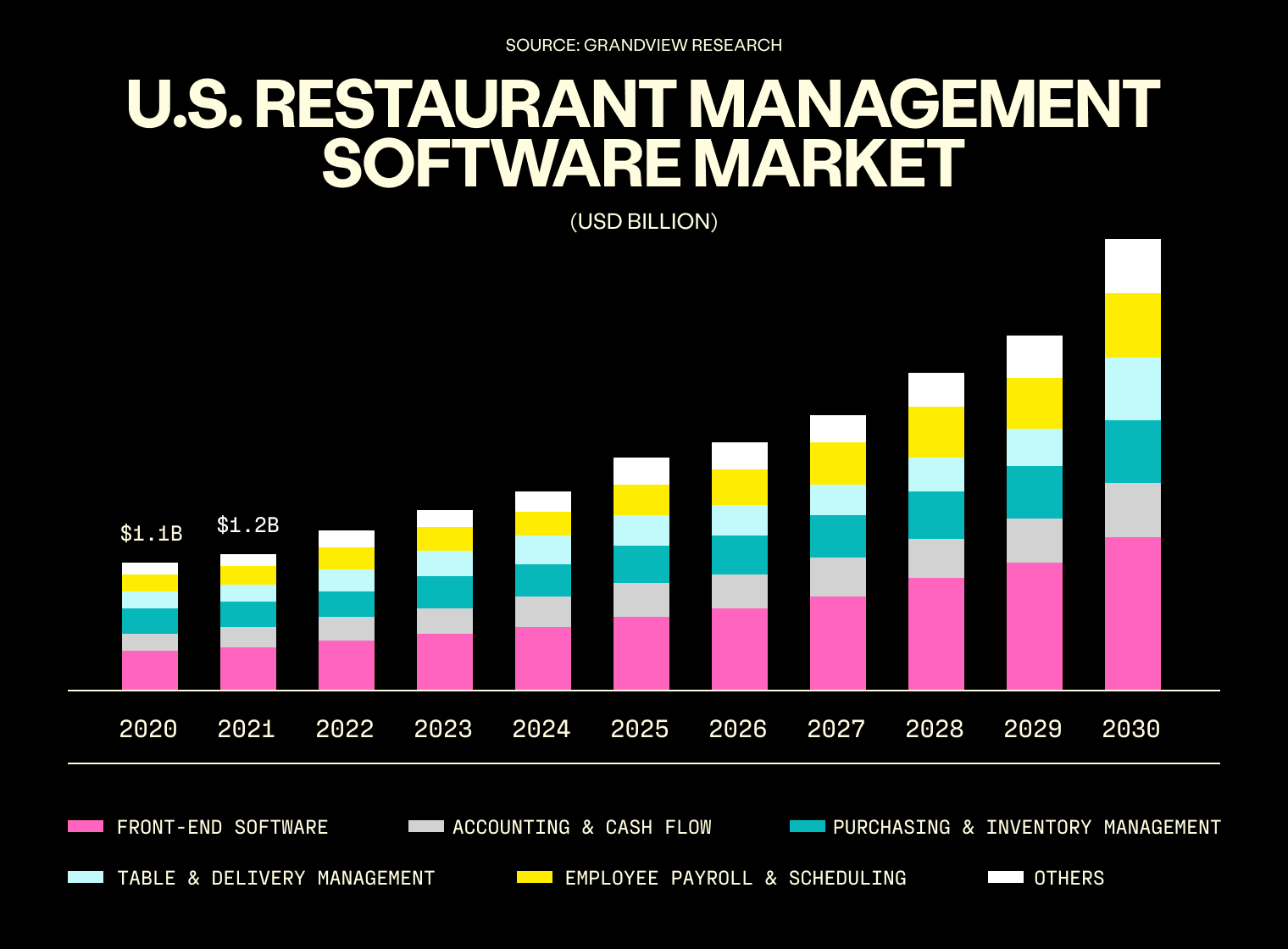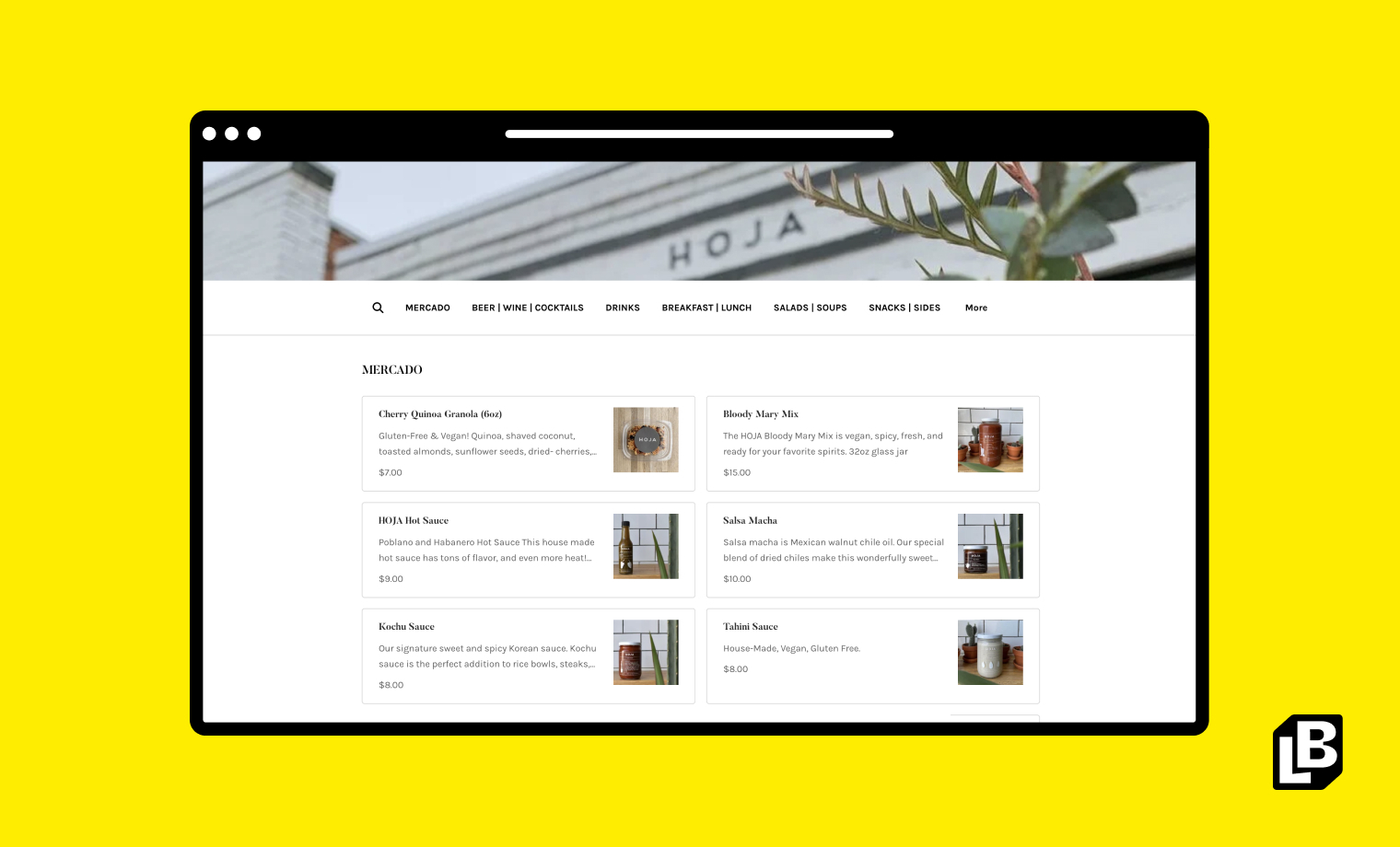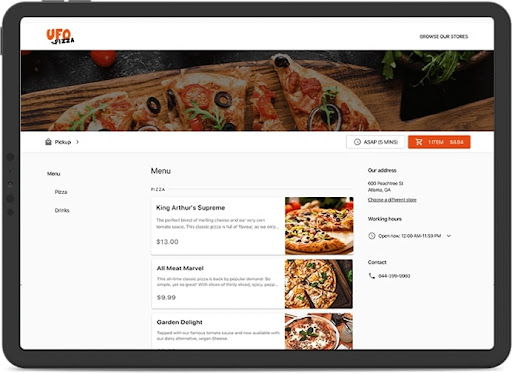Share
- Jump to:
Picture this: customer orders are written on scratch papers, haphazardly stuffed in aprons, and piling up in front of the order window. Someone is doing inventory manually in the back (and getting it wrong). The back-of-house (BOH) staff is yelling at one another. The phone is ringing, but no one has a free hand to answer it. You, the restaurant owner, knew that running a restaurant was difficult, but not THIS difficult.
Not ideal, right? This is not the restaurant you want to run, and this isn’t the restaurant customers want to eat at.
Now, imagine this: the SMS and email marketing campaign you created was a success, and customers have been steadily streaming in this week to try your new seasonal menu item. The new influx of customers hasn’t caused a strain on operations because by using data, you know who to staff and at what times. All orders are punched in via your POS system (eliminating paper scraps) and sent to the kitchen management software. The BOH team operates like a well-oiled machine, churning out perfectly plated dishes with little to no order mistakes.
This is what your restaurant would look like with the help of restaurant software.

The value of the restaurant software market has greatly increased in recent years and will continue to do so. Source: Grand View Research, 2022
So what exactly is restaurant software? This refers to any type of technology that can be used to operate a restaurant. This includes tools like online ordering systems, a modern POS (point-of-sale) setup, social media marketing tools, employee management, and kitchen management software.
Almost all restaurateurs (95 percent actually) report that using technology improves their business efficiency. Owners and operators will find that at least one form of software or management system, like kitchen management software or POS software, is crucial; multiple tools will optimize, automate, and streamline all parts of a restaurant business.
Reasons to Invest in Software
Investing in restaurant software is a no-brainer – it will save your business time, improve operations, and preserve the sanity of operators. Most restaurants use some type of software; using multiple or all-in-one software can give your restaurant a competitive edge. There are a plethora of reasons why restaurant software is worth the money; here are just a few to consider.
Ability to make better business decisions.
Restaurant software allows you to gather data from multiple points across your business. For restaurants, data is gold. Restaurant data can show how often a particular customer comes in, what the most popular menu item is, how your staff is performing, and when your slowest hours are. Equipped with this information, business owners can make well-informed decisions that will better their business.
Save money.
When operations are streamlined, this also ensures that money isn’t being unnecessarily wasted throughout your business. Kitchen management software can keep track of inventory, which will reduce overordering and food going to waste. Online ordering systems help limit phone orders, which can lead to incorrect orders (due to loud background noise and just human error). Repetitive tasks can be automated, therefore reducing the amount of staff. Employee management software can be incredibly helpful for scheduling staff only when they are most needed, which will reduce labor costs (typically one of the highest operational costs for restaurant businesses). Most restaurants already have razor-thin profit margins, so whenever money can be saved, profits can be increased.
Identify what marketing works.
Restaurant marketing can be costly and time-consuming, so when you commit to a marketing campaign, you’ll want to ensure that it is effective and reaches your objectives. One type of restaurant software category is marketing tools. This includes email marketing platforms, SMS marketing tools, social media, and websites. Your restaurant will likely choose to use multiple marketing tools, and it will take some trial and error to figure out which marketing solutions are the best fit for your business.
Types of Restaurant Software to Consider
There is a wide variety of software solutions for restaurants to choose from; chances are you will select multiple options or one or two more comprehensive choices. In your research, you might notice that some types of tools are overlapping. For example, if you have a POS system that also includes online ordering, you won’t need a separate system for this.
Consider pricing when comparing and researching software. Is it more affordable to buy one or two more comprehensive systems or several individual software tools?

Ideally, your online ordering platform should be able to be customized and match the existing branding of your restaurant. Here is an example of what a cafe’s online menu looks like. Source: Hoja, 2022
Online ordering.
With the explosion of ordering food online over the past few years, restaurants wanting to keep up definitely need online ordering software. Third-party platforms are, of course, one route to offering online ordering for your restaurant. Even though this is one way to quickly commence online ordering and increase your online presence, this option takes away from the ability to own your own brand. Your own online order system will allow for owning the online experience and full customization.
When researching an online ordering system, consider ease of integration, fees and costs, promotional support, access to customer data, and the ability to customize. Consider what features your restaurant needs, and remember that functionality is the most important feature. When it comes to pricing, most online ordering software options are offered in pricing tiers. For restaurants on a budget. Some offer basic options for $0 per month.
Examples:
Lunchbox: Offering a modern ordering system for restaurants, Lunchbox helps restaurants in growing their online revenue. Restaurants looking for major growth choose Lunchbox for native app and web ordering, loyalty, marketing, and third-party order aggregation.
Toast POS: Made exclusively for the food industry, Toast POS offers extensive features in addition to online ordering, like mobile app ordering, gift card purchasing, and contactless payment. The cloud-based system allows owners and operators to access restaurant data from anywhere.
Square POS: On top of online ordering,key features of Square POS include inventory reports, real-time sales data reports, customer profiles, and targeted marketing campaigns.

Revel’s POS system displayed on an iPad. Source: Revel, 2022
Point of sale.
Restaurant point-of-sale systems are simply where orders and sales are processed, but modern-day systems are so much more than payment processing. Many digitized restaurant POS systems serve to connect the back- and front-of-house, while also tracking inventory and customer ordering history. At this point, most customers already have the expectation of tapping their cards to a digital terminal or ordering tableside on a tablet.
Examples:
Revel: Supporting large to small businesses and all types of restaurants, Revel can be used on or offline. Although Revel was not created specifically for the restaurant industry, this option offers extensive features such as online ordering, loyalty programs, table management, and reservations.
Brink POS: Made specifically for the restaurant industry, Brink is an all-in-one system that can be used for a wide variety of food service establishments. Designed to grow with your business, Brink operates via the cloud for unlimited storage and increased security. Customized menus and personalized branding are two key features of this system.
Clover POS: Best for small to medium-sized food service establishments, Clover POS offers features like customer order history, employee management, loyalty programs, and mobile capabilities. This Android-based system offers third-party app integration to supplement features it does not have.
Delivery management.
In order to support online orders for delivery, your restaurant will need some form of delivery management. With many different restaurant and food service models, each establishment will want to consider which is the best option for their particular establishment. For example, a ghost kitchen will have greater needs for delivery management compared to a fine dining establishment.
Third-party delivery platforms are certainly an option, but there are pros and cons to this option (and certainly more cons than pros). DoorDash, Uber, and Grubhub are some of the most popular options for delivery services; these platforms charge transactional, service, and delivery fees, which cut into profit margins. The positive side to being listed as a restaurant on these delivery apps is that you will get your brand in front of many customers' eyes, therefore increasing your delivery/takeout orders and getting new customers to try your food.
If you need to get your food service operation delivery ready as soon as possible, third-party platforms may be a good place to start. However, using your own delivery management software will save your restaurant time. Additionally, having full control over the delivery process improves CRM (customer relationship management). When your customers need assistance with their delivery orders, third-party platforms may not provide the level of support, service, and care that your restaurant and staff could provide.
Some companies offer free software trials, and many offer their software services on a pricing tier to work with your restaurant’s budget.
Examples:
Tookan: A delivery software by Jungleworks, this online food ordering website, and delivery software includes features like a smart, all-in-one dashboard, the ability to launch marketing campaigns, and delivery tracking. Ordering can be completed via an app or website, and orders can be managed and edited with a single click.
OnTime360:Providing a vast amount of features such as driver tracking, advanced route scheduling, and a customer web portal, OnTime360 is available in nearly 300 countries. With a flexible pricing structure, OnTime360 is a good choice for many different sizes of restaurant operations.
GetSwift: Although this delivery software is not specific to the restaurant industry, it is used across six continents and 75 different industries. This delivery software can be integrated with your POS system, and send food orders directly to delivery drivers. Note that GetSwift offers a free, month-long trial.
Kitchen management.
Kitchen management software, also called food service or restaurant management software, is vital for automating all operations. This tool includes key features such as inventory management, order preparation information, employee management, menu planning, performance analytics, and food order tracking.
This particular form of software is often more comprehensive than others. As you can see, kitchen management software includes many features that are available with other forms of software. For example, depending on what kitchen management software you have, you may not need to also purchase a POS system or employee management software. If you do desire to purchase other software, ensure that they are easily integrated into your kitchen management software.
Examples:
XtraCHEF: This kitchen management software includes features such as food cost management, inventory, recipe management, AP automation, and real-time reports. The goal of this platform is to maximize restaurant profit margins via its financial and operational tools.
Restaurant365: Used by over 12,000 restaurants, Restaurant365 offers accounting, inventory, payroll, and reporting software. This software can be integrated into a restaurant’s POS system, and its operation and financial tools are all displayed in one convenient dashboard. A mobile app is also available.
Foodager: Key highlights of Foodager include menu planning, automated accounting, and streamlined ordering. Small and multi-unit establishments, from QSRs to full-service restaurants, can use this software to save money and maximize profits.

TapMango allows customers to enroll in loyalty programs via SMS, mobile apps, tablets, and on the web. Source: TapMango, 2022
Customer loyalty.
Customer loyalty doesn’t only extend to customer support – you need to incentivize your customers to keep coming back. To do this, consider using customer loyalty programs. This type of software could include a custom app, an online program, or a sign-up system. Rewarding customers for spending at your establishment incentivizes them to come in on a regular basis.
Although punch cards are a very popular option for customer loyalty, this is not necessarily the most effective option. Customers don’t only eat or drink at your establishment, and chances are they have multiple loyalty punch cards piling up in their wallets or purse. Also, consider how easy it is to lose or misplace one of these punch cards.
A digitized option is often going to be the more effective and convenient option for your customers. Note that some POS systems do offer customer loyalty options.
Examples:
Preferred Patron: This is one of the original customer loyalty programs, and allows your restaurant business to create a customized app. It offers a mobile app for both Apple and Android, as well as on-demand reporting.
ReUp: This loyalty program offers both digital and physical options (such as key tags) to accommodate all customer preferences. The ReUp calculator allows your business to figure out its loyalty program yearly ROI.
TapMango: This software tool is a customizable feature-rich customer loyalty program and online ordering platform. Set-up only takes 30 minutes.
Marketing tools.
Marketing is expensive and time-consuming; therefore, as a restaurant, you’ll want to only use the most effective marketing tools. Consider who your target customer is and the best way to reach them. Figuring out what marketing tactic is best for your restaurant will take some trial and error, so be creative, and patient, and try multiple options at once.
Marketing tools for a restaurant can include social media, SMS, email marketing platforms, and ads. The software can be used to manage multiple campaigns at once, giving operators the ability to track success in real-time. SMS, or direct messaging, can be used to confirm reservations, share about specials, update customers about the waitlist, or send a thank you to a customer after their meal. Emails can be used to send out promotions, reminders, and personalized messages.
Examples:
Hootsuite: With Hootsuite, restaurants can save time by scheduling posts across all social networks in just a few clicks. Content can be reviewed in a simple calendar view, and then immediately posted to your business’s accounts.
SproutSocial: As an all-in-one social media management platform, SproutSocial allows its users to publish and manage content across multiple platforms. The platform emphasizes several components of social media effectiveness, including monitoring, engagement, measurement, and growth.
Benchmark: This email marketing platform is for any business that wants to send personalized emails at scale. This software offers email templates, encourages more website visitors to become subscribers, and integrates with other marketing tools.
Employee management.
Manually managing your staff schedule can be a pain for operators. Too often, communication about schedule and shift changes falls through the cracks – luckily, having good software can remedy this.
Employee management software can ensure that everything from scheduling to training runs smoothly and automatically. In addition to scheduling, employee management may include performance tracking, hiring, and training. A digital scheduling system can create staff schedules for you, and allow employees to easily request time off and shift swaps, eliminating paper forms.
Examples:
7Shifts: This employee scheduling and time clock tool was made for the restaurant industry, and therefore, understands how to save restaurants money and time. Pricing is flexible and is based on desired features, team size, and the number of locations.
Wisetail: This onboarding and training software can help ensure consistency, reduce onboarding time, support rapid growth, and communicate company culture. Wisetail also features operational tools, such as to-do lists, as well as tracking and reporting features.
Deputy: Created for the hospitality industry, Deputy aims to reduce labor costs and deliver outstanding service. Key features include staff scheduling, accurate timesheets, staff engagement to improve performance, and the simplification of wage and hour compliance.
Accounting and payroll software.
Let’s face it – accounting and payroll may be one of the most boring parts of running a restaurant or food service operation. However, this back-office job is what makes your restaurant run – your employees need to get paid and finances need to be managed. Having the right software can make this process far less dreadful and time-consuming.
Examples:
Restaurant365: The accounting software is an all-in-one cloud-based solution that also provides operational and reporting tools to position restaurants for growth. This platform’s APIs allow for integration with other systems such as POS systems, banks, and vendors.
QuickBooks Online: From restaurants to food trucks, QuickBooks can easily help all types of establishments track income and expenses. Additionally, this software allows you to have important data at your fingertips, monitor food costs, manage labor costs, and pay employees.
KitchenSync: This accounting software can provide online bookkeeping and payroll services to restaurants, franchises, and hospitality groups. KitchenSync can be connected to your bank and restaurant POS software and operates as outsourced finance, HR, recruiting advisory, and marketing department
To be the best restaurant you can be, you need restaurant software. Running a restaurant is not for the faint of heart, and with so many moving parts, there is not much room for error. Restaurant software can be used to help optimize every part of your restaurant, from online ordering to managing employees. With profit margins seemingly getting tighter every year and the restaurant industry becoming increasingly competitive, restaurant software helps ensure that your establishment is set up for success. Most restaurateurs and operators are using at least one form of restaurant software – are you?